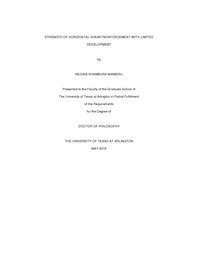
ATTENTION: The works hosted here are being migrated to a new repository that will consolidate resources, improve discoverability, and better show UTA's research impact on the global community. We will update authors as the migration progresses. Please see MavMatrix for more information.
Show simple item record
| dc.contributor.author | Waweru, Regina Nyambura | en_US |
| dc.date.accessioned | 2015-07-31T22:10:24Z | |
| dc.date.available | 2015-07-31T22:10:24Z | |
| dc.date.submitted | January 2015 | en_US |
| dc.identifier.other | DISS-13215 | en_US |
| dc.identifier.uri | http://hdl.handle.net/10106/25140 | |
| dc.description.abstract | In order for the composite action between the precast beam and the cast-in-place deck to be effective, sufficient horizontal (interface) shear strength needs to be provided at the interface of the two concrete elements to prevent slip. Horizontal shear strength is provided by three main components: the protrusions on the crack faces (cohesion/aggregate interlock), friction between the faces resulting from the normal compressive stress, and the dowel action of the reinforcing bars. AASHTO LRFD equation assumes that all reinforcement crossing the interface would be fully developed on both sides of the interface at ultimate shear strength. This study examines if adequate horizontal shear capacity is provided by a very short embedded length (approximately 2-in.) commonly used in composite slab and box bridge beams in Texas. A number of component test that included push-off test and bar pullout tests were conducted to evaluate each component of horizontal shear. Seven full-scale composite prestressed bridge beams were tested to evaluate the contribution of dowel action of the reinforcement on horizontal shear capacity. These beams included two beams designed according to the current TxDOT specifications and two beams designed without any horizontal shear reinforcement. The interface area was reduced in the last three full-scale beams so as to force a horizontal shear failure and hence obtain the horizontal shear strength in those specimens. Results revealed that although the component tests show that the interface reinforcement with 2-in. embedded length could not be fully developed, the full-scale tests (with reduced interface area) indicate that the actual boundary conditions in the composite beams could provide abundant confinement to develop the reinforcement. Experimental results show that current AASHTO provisions for horizontal shear in composite concrete beams could over-estimate the horizontal shear contribution from dowel action of the reinforcement and do not represent the true behavior of the horizontal shear resistance mechanism. | en_US |
| dc.description.sponsorship | Chao, Shih-Ho | en_US |
| dc.language.iso | en | en_US |
| dc.publisher | Civil & Environmental Engineering | en_US |
| dc.title | The Strength Of Horizontal Shear Reinforcement With Limited Development | en_US |
| dc.type | Ph.D. | en_US |
| dc.contributor.committeeChair | Chao, Shih-Ho | en_US |
| dc.degree.department | Civil & Environmental Engineering | en_US |
| dc.degree.discipline | Civil & Environmental Engineering | en_US |
| dc.degree.grantor | University of Texas at Arlington | en_US |
| dc.degree.level | doctoral | en_US |
| dc.degree.name | Ph.D. | en_US |
Files in this item
- Name:
- Waweru_uta_2502D_13215.pdf
- Size:
- 25.42Mb
- Format:
- PDF
This item appears in the following Collection(s)
Show simple item record


